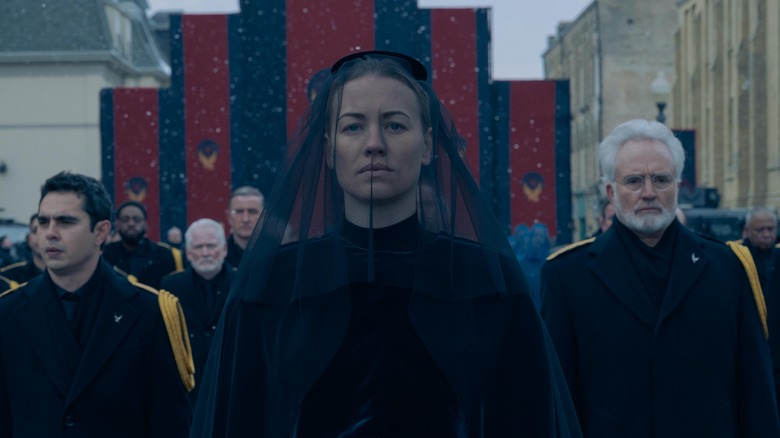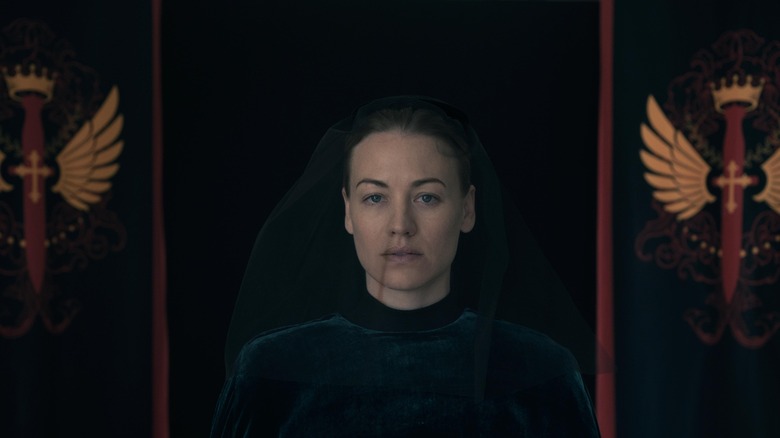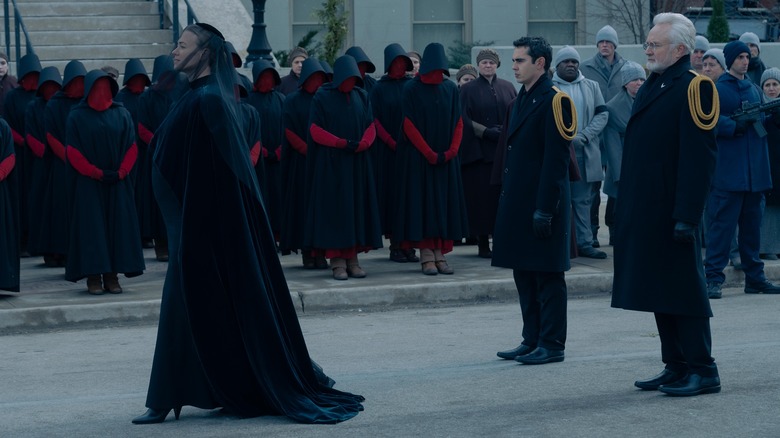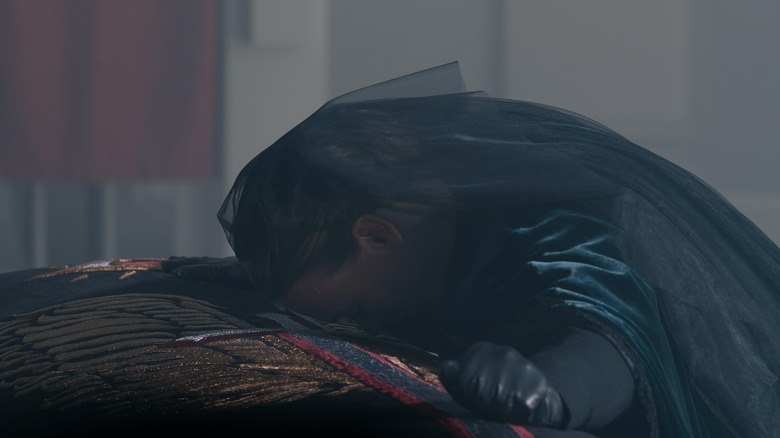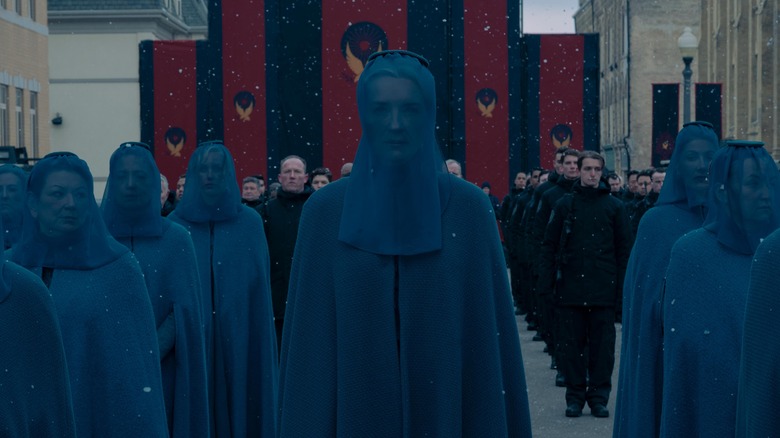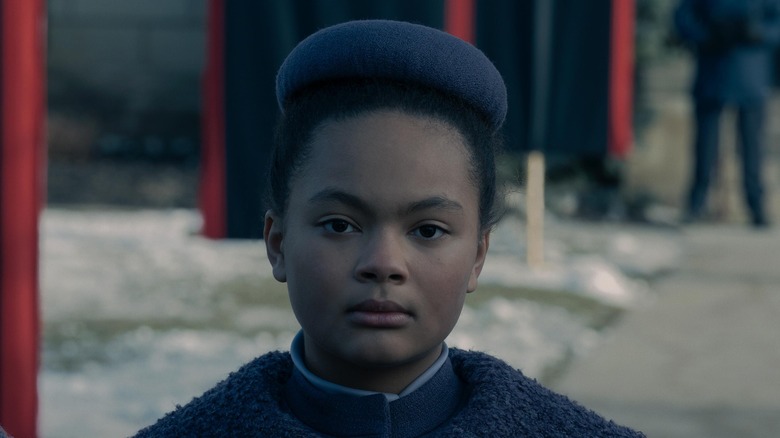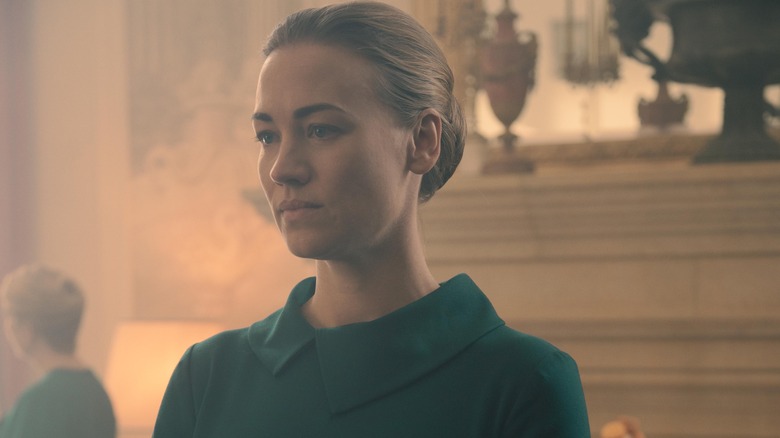Details About Fred's Funeral In Season 5 Of The Handmaid's Tale That You May Have Missed
Mercy and compassion are two things Gilead is in short supply of, yet it's what they hope to sell the world they have as we tune in to Season 5, Episode 2 of "The Handmaid's Tale." Serena Waterford, either newly empowered or forgetting where women actually stand in Gilead, demands a funeral for Fred fitting of a "founding father." This requires a game of mental chess that, without Fred, Serena only has the powers of a pawn to play.
According to executive producer Warren Littlefield, "gamesmanship" is what Season 5 is all about. "Yes, [Serena] wants to honor Fred, but this is Serena Joy's stepping in and getting on the throne, and she's masterful. She's powerful. She's a great chess player," Littlefield told TV Line.
We know, of course, that Serena can run intellectual and logical laps around most of the Commanders on the High Council — the men who seem to be running Gilead. However, any idea she presents is shot down, continuing this season's theme of psychological torture over physical.
"There's just a lot of women bumping up against the narrow, invisible walls that constantly restrain their freedom," Vulture writes about "Ballet." However, it's hard to notice the walls in this episode since they look so similar to "the wearying, psychological horror of being trapped in a world that values only what your body can provide to men and hides its violence beneath a thin barrier of chivalry in public" — aka what women today are already very familiar with.
The Gilead flag changed again
As we all just witnessed with Queen Elizabeth II's funeral, state funerals are no joke. Everything is controlled — a strict mourning dress code in place, just like with the royal family — and there is a heightened feeling of nationalism, a side-effect of flag-lined streets. Over the past few seasons, Gilead's flag has not only evolved but it's become a more prominent aspect of the landscape.
In Season 1, we barely see the Gilead flag; while Cambridge might've been the epicenter of June's Gilead experience, we learn in Season 3 things are much worse elsewhere. When June is taken to Washington D.C., there's a shift away from religious-heavy symbolism to an extremely authoritarian vibe. According to Sean Schoffield, a member of the graphic design team for "The Handmaid's Tale," that was on purpose.
Schoffield explained to Refinery29, in "The Handmaid's Tale," there are only two significant sources of bright color: the Handmaid's robes and Gilead's flags. Before, when June's world was limited to a Gilead-ified Cambridge, we barely saw their flag, but it was there: a black eagle carrying an olive branch with a gold sunburst on a white field.
Now, the flag and the uniform shared the same dominating color: red. The black and red is meant to specifically invoke Nazi Germany, Schoffield says. But for Fred's funeral, the colors got an inversion — red on black with gold, a crowned sword with wings — as well as black bars around the normal red flag.
Serena's funeral outfit was more symbolic than you think
Serena's pregnancy isn't the only aspect of her character that's symbolic in Season 5, Episode 2 of "The Handmaid's Tale." As we've seen before, Gilead goes out of its way to choreograph mourning rituals, but those pale in comparison to the theatrics that went into every aspect of Fred's funeral — Serena's outfit included.
During an interview with Insider, showrunner and creator Bruce Miller explained that the veil Serena wore during Fred's funeral was inspired by the one former First Lady Jackie Kennedy Onassis wore during former president John F. Kennedy's funeral.
Played by Yvonne Strahovski, Serena is seen zipping up knee-high boots under her floor-length black dress, that sometimes seems to look teal in the faded saturation of this show. Long-sleeved and long-veiled, both Serena and Onassis' funeral outfits draw inspiration from Queen Victoria. According to the BBC, the late queen set the standard for mourning attire.
Serena and Onassis both also wore long, black veils, though Serena's is notably more dramatic. Mourning veils, the BBC explains, were supposed to provide the mourner protection from public eyes. However, just like Onassis, Serena's veil obscured her face just barely, especially in comparison to the other wives and handmaids, whose faces were completely obscured by their hoods and veils.
As Vulture points out, Serena's also dressed very reminiscent of "Italian widow in its fascist heyday," showing the two warring perspectives: how Serena sees herself and the righteousness of her cause vs. reality.
The other ways Commander Waterford's funeral was inspired by President John F. Kennedy's
Serena's funeral dress and veil weren't the only aspects of Fred's funeral inspired by the funeral held for former President John F. Kennedy. The choice to have her walking alone in the procession behind Fred was deliberate, according to showrunner Bruce Miller. In an interview with Insider, he explained that he had "loved the fact that for the most part, the first lady was walking alone." For him, it made Jaqueline Kennedy Onassis' sadness "bare and raw."
Miller also chose to include a riderless horse carrying a saber and boots reversed in the empty saddle's stirrups as a nod to Kennedy's funeral. These symbols, Life explains, are meant to symbolize a "fallen warrior" — the image of Fred that Serena is trying to sell to the world, and maybe even to herself.
Even the weather was similar. During the same interview with Insider, executive producer Warren Littlefield pointed out that "the world was cold and gray" when they were filming Fred's funeral, an effect they were able to enhance by adding snow flurries.
Other details of Fred's funeral were similar to other state funerals we've seen: streets lined with mourners. Just like when horses drew President Kennedy's flag-draped casket through the streets of Washington D.C. and into Arlington Cemetery, the only sound in Gilead was the sound of Fred's casket being pulled down the street (via Life).
But yeah, Fred's funeral also had major fascist overtones
For as patriotic of an event as Serena and the High Commanders want the funeral to be, however, it's not positive patriotism that the spectacle provokes. We can't be the only ones who felt like they were re-watching the scene from Season 2, Episode 9 of Netflix's "The Crown" where Prince Philip attends the funeral of his sister, a high-ranking member of the Nazi party. In both television shows, snow falls over silent streets lined with mourners as black and red flags and eagles take the place of prominence in the scene.
A practice in propaganda for both Gilead and the Nazi Regime, these funerals-turned-major events were meant to "raise the stature and the legitimacy" of their message, Bradley Whitford, aka Commander Joseph Lawrence, explains during a featurette for the episode. "They'll see us as merciful," Nick had told the council when trying to convince the other commanders to go along with Serena's plan earlier in the episode. With the pregnant, grieving widow as the camera's main focus, how could the world not soften its view of this nation that swears they only want to help increase the birth rate and save the world against climate change?
The Nazi Regime regularly used this type of visual propaganda and emotional manipulation to ensure public support for their horrific acts. Building information campaigns by exploiting tragedies were, as The History Press points out, a cornerstone of the Nazi takeover plan.
Also: June's daughter, Hannah, is no longer a little girl
The fact that Hannah is a child — a precious resource in Gilead and in the rest of this dystopian mirror world — but it's never stopped Serena Waterford from using her as a way to control June. We saw it back in Season 1, Serena drives June to where Hannah is and promises that Hannah will stay safe as long as "her" baby — Nichole, who June was pregnant with at the time — stayed safe (via TV Line).
In Season 2, June was given time with Hannah at Commander Putnam's lake house. Again, this was meant to be an incentive for June, still pregnant at this point, to follow the rules. Stay in line, your child won't get hurt — but these visits only intensified June's desire to get out of Gilead and take her daughters with her.
In Season 5, Episode 2, Hannah is again used to send a message to June: Serena can get to Hannah, who — dressed in purple, not pink — is no longer a little girl. She's onto the next phase of her training to be a Gilead wife.
Like Tuello warned June in Season 5, Episode 1, Serena is dangerous when she's scared. Bruce Miller told The Hollywood Reporter Serena has "no intention" of rolling over and letting June win this war, something Miller doesn't think June realizes or understands. "She just didn't think about what came next," he said, adding that, "what came next is a really scary Serena."
Did you see these Season 1 Easter eggs?
Everything wasn't completely doom and gloom this episode, especially if you were paying attention to the smaller details. Just like in Season 4, we're experiencing situations through an outsider's perspective — only this time, we're back in Gilead, experiencing their events through the eyes of Tuello, the keen-eyed American getting an exclusive behind-the-scenes look into the traditions of this high secretive new country.
Death in Gilead can be treated as elegant as birth, depending on who is being celebrated. For Commander Waterford, there is a tasteful wake at the home of Commander and Mrs. Putnam, the same setting for when Janine gave birth to Angela in Season 1, Episode 2, "Birth Day." Just like for the birth of baby Angela, there is quite the feast spread out for the wives and commanders — who stay separated by gender the entire episode, words barely above a whisper. The handmaids are led in by Aunt Lydia. Did you notice the macaron tree?
Just like in Season 1, Episode 2, a handmaid — in this case, Esther — has her first encounter alone with her commander. In this case, however, everyone, Aunt Lydia included, knows that she's alone in Commander Putnam's study. For June, it was only Nick and then the other handmaids she told that knew about her Scrabble sessions with Commander Waterford. These, too, were referenced at the beginning of Season 5, Episode 2, when June has a traumatic flashback to her nights spent with Fred.
